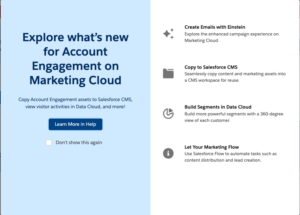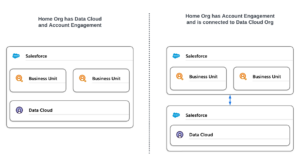Everything you need to know about using Salesforce Record Types with Account Engagement
- December 30, 2024
- Unfettered Marketing


Did you know that you can work with different lead and contact record types with Account Engagement? This is one of those capabilities that unless you have a strong Salesforce administrator knowledge, a marketer might not even know about, but for the orgs that use multiple records types, it’s an interesting capability to have available, and yet one that can also be fraught with challenges.
What’s a Record Type?
Simply put, it’s a way of organizing information in Salesforce that allows you to collect and display record information differently depending on some pre-determined criteria. A simple example might be that you could have 2 different record types on leads for new leads collected by marketing vs ones manually entered by sales.
Here are a few key things to understand about record types as concerns Account Engagement (f/k/a Pardot)
-
A default record type is assigned to a profile, meaning that the default type for that profile is used when creating a new record unless an alternate type is specified.
-
Fields and field data exist in all record types even if the field does not appear in that record type’s page layout.
-
Leads and Contacts have separate record types and how they are named matters. (more on this later)
-
Record types can be completely hidden from some users, if that is part of the org security policy.
How do I connect Record types to Account Engagement?
It’s surprisingly easy to do. Just create a custom prospect field in Account Engagement, and look for the RecordTypeId field as the Salesforce.com field name. Now here’s the first tricky part– it’s not the ID you need for the possible values, it’s the NAME of the record type. I recommend using a dropdown for the values. The second tricky part is that if you have different available names for lead and contact record types, you need to have all the possible names for leads and contacts available here.
Another really important thing to understand about this capability is you have not only the ability for Account Engagement to set the record type on a record create, but also change it, which is not necessarily what you might expect. This is why the sync behavior (use Saleforce’s Value, use Account Engagement’s value, use most recently updated record) is especially important to consider in the context of how you intend to work with record types. Do you want account Engagement to set the value only on create? Then allow Salesforce to control the value. Do you want to allow Account Engagement to change the record type under certain conditions? Then use most recently updated record…but be careful, that’s where unintended consequences may occur. I can’t see many scenarios where Account Engagement would solely control record type.
This is where the often overlooked “usage” table on a custom field is really useful. When you connect record types, keep a close eye over time on what system resources are using that field using the usage table to make sure that there isn’t some overlooked automation or form that’s setting the record type where you don’t want it to.

Now I have a custom field for Record Type, what can I do with it?
First thing is to decide what the default record type is for your B2BMA or connector user, and assign that on the Lead and Contact. In the absence of any other action, any new records created by the connector user will be the default type. So think of the alternative record types as the non-standard record types. If you don’t assign anything to the RecordTypeId field, it will just use the default.
Here are some possible scenarios. Remember you need to carefully consider these in combination with your field sync behavior– whether you are going to allow Account Engagement to change the record type on an existing record.
-
Set the record type on the creation of a record. (the CRM status is “not assigned”, generally). Perhaps this is based on the acquisition channel via forms, or a record upload via Account Engagement.
-
Change the record type based on prospect behavior (maybe hold records in a record type that is hidden from sales until some type of definitive action occurs)
-
Use Conditional Completion actions to set or change the record type based on field input, or if the record is already a lead or contact. Note that the limitations of conditional completion actions means that you can’t use both field inputs and the present state at the same time, so you might have to get creative.
-
Pass the record type ID as a field via form handler
-
Change record types via automation based on scoring/grading or Account Engagement profiles.
Remember, if you just want a new record to use the default type, you don’t have to set anything. And realize that the record type for the connector user doesn’t have to be the same as the other users’ default!
What are potential issues to watch out for?
The most common one is a mismatch between the lead and contact record type names. In certain circumstances, you can end up with a sync error where Account Engagement is trying to change a record type and that record type name is not available on the synced object (lead or contact).
As also noted, if the the sync behavior is set for the most recently updated record and your completion actions or automations cause a reversion of record type that causes the record to be hidden or otherwise behave in an unexpected manner.
An example of an unexpected behavior that also might cause an issue (and was originally a question in the Trailblazer community that inspired this article) is what happens if someone fills out a form on your website and were not originally in Account Engagement, but were already a contact in Salesforce? And one of the actions of that form were to set the lead record type? The result would be that they record would sync, connect with the contact, and Account Engagement would attempt to change the record type to the lead type name– which if it were not also a contact type name, would cause a sync error (presuming the sync behavior was set to use the most recently updated record). So you can see that there’s quite a lot to think about.
My Best Practice Advice
When considering using record types, start here:
Confer with your admin and developers to understand why your org has multiple record types, how and why are they used, and how Account Engagement can be used to enhance these processes.
Start simple with only allowing Account Engagement to set the record type on NEW records. This means the sync setting on the custom field would be set to Use Salesforce’s value, which means any pre-existing record won’t allow Account Engagement to change the record type.
This Pardot article written by: Bill Fetter
Unfettered Marketing
A collection of random thoughts on how people, places and things in our fascinating world connect to sales and marketing, and what we can learn from it.
Original Pardot Article: https://www.unfetteredmarketing.com/post/everything-you-need-to-know-about-using-salesforce-record-types-with-account-engagement
Find more great Pardot articles at https://www.unfetteredmarketing.com/blog
Pardot Experts Blog
We have categorized all the different Pardot articles by topics.
Pardot Topic Categories
- Account Based Marketing (ABM) (7)
- Business Units (14)
- ChatGPT / AI (3)
- Completion Actions (5)
- Connectors (10)
- Custom Redirects (4)
- Data Cloud (3)
- Demand Generation (8)
- Dynamic Content (7)
- Einstein Features (11)
- Email Delivery (17)
- Email Open Rates (3)
- Pardot A/B Testing (2)
- Email Mailability (16)
- Do Not Email (1)
- Double Opt-in (2)
- Opt Out / Unsubscribe (14)
- Email Preferences Page (6)
- Engagement Studio (16)
- Industries (1)
- Non Profit (1)
- Landing Pages (9)
- Lead Generation (1)
- Lead Management (13)
- Lead Routing (3)
- Lead Scoring (16)
- Leads (3)
- Marketing Analytics – B2BMA (9)
- Marketing Automation (1)
- Marketing Cloud (3)
- Marketing Cloud Account Engagement (4)
- Marketing Cloud Growth (2)
- New Pardot Features (6)
- Opportunities (2)
- Optimization (2)
- Pardot Admin (65)
- Duplicates (1)
- Marketing Ops (1)
- Pardot Alerts (1)
- Pardot API (2)
- Pardot Automations (3)
- Pardot Careers (12)
- Pardot Certifications (4)
- Pardot Consulting (1)
- Pardot Cookies (4)
- Pardot Custom Objects (3)
- Pardot Email Builder (8)
- Pardot Email Templates (10)
- HML (6)
- Pardot Events (17)
- Pardot External Actions (1)
- Pardot External Activities (4)
- Pardot Forms (29)
- Form Handlers (8)
- Pardot Integrations (21)
- Data Cloud (2)
- Slack (1)
- Pardot Lead Grading (5)
- Pardot Lead Source (2)
- Pardot Lightning (1)
- Pardot Migration (1)
- Pardot Nurture / Drip Campaigns (2)
- Pardot Personalization (3)
- Pardot Profiles (1)
- Pardot Releases (18)
- Pardot Sandboxes (2)
- Pardot Segmentation (5)
- Pardot Strategy (7)
- Pardot Sync (2)
- Pardot Sync Errors (1)
- Pardot Tracker Domains (5)
- Pardot Training (3)
- Pardot Vs Other MAPs (4)
- Pardot Website Tracking (2)
- Reporting (22)
- Salesforce and Pardot (31)
- Marketing Data Sharing (2)
- Pardot Users (3)
- Salesforce Automation (5)
- Salesforce Flows (2)
- Salesforce Campaigns (22)
- Salesforce CRM (3)
- Record Types (1)
- Salesforce Engage (3)
- Salesforce Queues (2)
- Security and Privacy (1)
- Tags (3)
- The Authors (540)
- Cheshire Impact (9)
- Greenkey Digital (55)
- Invado Solutions (37)
- Jenna Molby (9)
- Marcloud Consulting (6)
- Nebula Consulting (67)
- Pardot Geeks (44)
- Salesforce Ben | The Drip (242)
- SalesLabX (16)
- Slalom (4)
- Unfettered Marketing (51)
- Uncategorized (1)
- Website Tracking (2)
- Website Search (1)
More Pardot Articles
See all posts
This Pardot article written by: Bill Fetter
Unfettered Marketing
A collection of random thoughts on how people, places and things in our fascinating world connect to sales and marketing, and what we can learn from it.
Original Pardot Article: https://www.unfetteredmarketing.com/post/everything-you-need-to-know-about-using-salesforce-record-types-with-account-engagement
Find more great Pardot articles at https://www.unfetteredmarketing.com/blog






